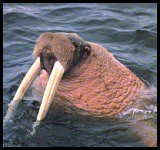
 Big Mamma! Walrus calves are usually born on the ice, and by one month of age, they are strong swimmers. A cow is extremely protective of her calf. She may shelter it under her chest between her foreflippers, or take it for a ride on her back in the water. Nursing cows usually gather in herds separate from the bulls and other females. These "nursery herds" usually include 20 to 50 individuals but may include as many as 200 walruses. Calves usually nurse for about two years, and they grow quickly (about 10-15 cm / 4-6 inches in length each month) on their mothers' fat-rich (about 30%) milk. Air sacs in the neck of the walrus allow it to sleep with its head held up in the water, and nursing females use this "standing" position as they nurse. The pups nurse upside down when they're in the water. Walruses have large, rounded, spindle-shaped bodies covered with a thick layer of blubber that makes them very slow and awkward on land (but great divers and swimmers), and this presents a danger to calves. Adult walruses occasionally crush them as they lumber through the herd, but this is usually accidental clumsiness, and not aggressive behavior.
Click pictures for more information and credits. Library: Arctic, Arctic Animals Links: Arctic, Arctic Animals Arctic Maps & Weather Reports |

|
DICTIONARY: Just "double-click" any unlinked word on this page for the definition from Merriam-Webster's Student Electronic Dictionary at Word Central. |

|
ARCTIC LIBRARY & GLOSSARY: Check this section for an index of the rest of the things you really need to know about the Arctic. |

|
ARCTIC MAPS & WEATHER REPORTS: Maps of the Northwest Passage, explorers' routes, iceberg sources, Nunavut, the Arctic by treeline, temperature... |

|
ARCTIC LINKS: Even more information! Links to sites related to the Arctic and "Iceberg: the Story of the Throps and the Squallhoots". |

|
GUIDE TO ARCTIC SUNRISE & SUNSET: How much sunlight or darkness is there in the Arctic on each day of the year? |
to is the property of their respective owners, and Athropolis is not responsible for their content.